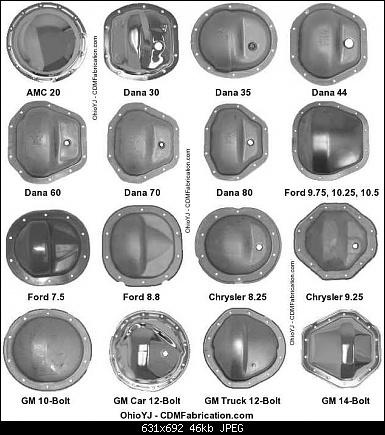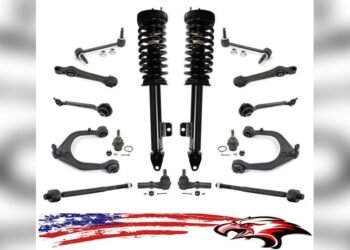If you’re upgrading your truck or planning a heavy-duty build, choosing the right axle is crucial. You’ve probably come across Dana 70 and Dana 80 axles, two popular options that can make or break your vehicle’s performance.
But which one suits your needs best? Understanding the differences between these two can save you time, money, and frustration down the road. You’ll discover the key features, strengths, and applications of Dana 70 vs Dana 80, helping you make a confident choice for your ride.
Keep reading to find out which axle will give your truck the power and durability you’re looking for.

Credit: en.wikipedia.org
Axle Basics
An axle is a key part of any vehicle’s drivetrain. It connects the wheels and supports the weight of the vehicle. Axles also help transfer power from the engine to the wheels. Understanding axle types helps in choosing the right one for your needs. Dana 70 and Dana 80 are two popular heavy-duty axles used in trucks. Each has unique features that affect performance and strength.
Dana 70 Overview
The Dana 70 axle is known for its strength and durability. It has a ring gear diameter of about 10.5 inches. This size helps it handle heavy loads and tough conditions. Dana 70 often comes with a full-floating design, which means the axle shaft does not carry the vehicle’s weight. This makes it more reliable for heavy-duty use. Many trucks and vans use the Dana 70 for both front and rear axles. Its maximum gross axle weight rating (GAWR) varies but can support around 7,500 pounds or more.
Dana 80 Overview
The Dana 80 axle is larger and stronger than the Dana 70. It has a bigger ring gear, approximately 11.25 inches in diameter. This extra size adds strength and durability. Dana 80 is mainly used for rear axles in heavy trucks. It also features a full-floating design for better load support. The maximum GAWR for Dana 80 can reach up to 10,000 pounds or more. It is common in heavy-duty GM and Ford trucks and vans. This axle is ideal for vehicles that need higher load capacity and tough performance.
Strength Comparison
The strength of axles is key for heavy-duty use. Dana 70 and Dana 80 are popular choices. Both are strong but differ in key areas. This section compares their strength to help you understand which suits your needs.
Ring Gear Diameter
The ring gear is crucial for torque transfer in axles. Dana 80 has a larger ring gear diameter, measuring about 11.25 inches. Dana 70’s ring gear is smaller, around 10.5 inches. A larger ring gear means more strength and durability. This makes the Dana 80 better for handling higher loads and rough terrain.
Gross Axle Weight Rating
Gross Axle Weight Rating (GAWR) shows how much weight an axle can support. Dana 70 typically has a GAWR near 7,500 pounds. Dana 80 can handle more, often rated up to 10,000 pounds. This higher rating means Dana 80 can carry heavier loads safely. For tasks that involve heavy cargo or tough work, Dana 80 offers a clear advantage.
Bearing Types
Bearings keep the axle rotating smoothly. Dana 70 uses standard tapered roller bearings. Dana 80 features larger, heavy-duty bearings for extra support. These bearings reduce wear and improve strength under stress. Stronger bearings in Dana 80 increase its lifespan and reliability, especially in demanding conditions.
Design Differences
The design differences between Dana 70 and Dana 80 axles are key to their performance. These differences affect strength, durability, and suitability for various trucks. Understanding these design aspects helps in choosing the right axle for your needs.
Axle Housing
The Dana 80 features a thicker axle housing than the Dana 70. This thicker housing offers better strength and resistance to bending. Dana 80’s housing is designed to handle heavier loads and rougher conditions. Dana 70 has a lighter housing, making it suitable for moderate-duty use.
Full-floating Vs Semi-floating
Both Dana 70 and Dana 80 use full-floating axle designs in most models. Full-floating axles support the vehicle’s weight on the axle housing, not on the axle shafts. This design allows for better durability and easier maintenance. Some Dana 70 variants may have semi-floating options, but Dana 80 is primarily full-floating.
Truss And Clearance
Dana 80 axles often include a heavy-duty truss for added rigidity. The truss helps reduce axle flex under heavy loads. Dana 70 axles may not have as robust a truss, affecting their strength in extreme use. Clearance around the truss and axle varies, with Dana 80 designed to fit larger tires and suspension setups.

Credit: garage.grumpysperformance.com
Performance And Durability
Performance and durability are key factors in choosing between the Dana 70 and Dana 80 axles. Both axles are designed for heavy-duty use. They handle tough conditions and support heavy loads. Understanding their differences helps in picking the right axle for your needs.
Load Capacity
The Dana 80 has a higher load capacity than the Dana 70. It can handle more weight without bending or breaking. Dana 70 axles support up to 7,500 pounds per axle. Dana 80 axles can support up to 8,000 pounds or more. This makes the Dana 80 better for heavier trucks and trailers.
Oil Capacity
Oil capacity affects axle cooling and lubrication. The Dana 80 holds more oil than the Dana 70. More oil means better heat dissipation. This helps the axle stay cooler during long hauls. The Dana 70’s lower oil capacity suits moderate workloads. Proper oil levels reduce wear and extend axle life.
Wear And Maintenance
Both axles require regular maintenance to perform well. Dana 80 parts are usually more robust and last longer. The Dana 70 may need more frequent checks and repairs. Regular oil changes and inspections reduce wear on gears and bearings. Proper maintenance ensures durability and avoids costly breakdowns.
Applications
The Dana 70 and Dana 80 axles serve different purposes in vehicle setups. Both offer strong performance but fit specific needs better. Understanding their applications helps in choosing the right axle.
These axles are common in heavy-duty vehicles. They handle tough loads and rough terrains. Their design influences which vehicles and uses suit them best.
Vehicle Compatibility
The Dana 70 fits many heavy-duty trucks and vans. It is common in GM and Ford models. The Dana 80 is found in larger trucks and commercial vehicles. It supports higher weight and stronger demands.
Common Use Cases
The Dana 70 works well for hauling and towing medium-heavy loads. It is popular in work trucks and utility vehicles. The Dana 80 suits very heavy loads and commercial hauling. It handles extreme weight and stress better.
Off-road Performance
Both axles provide solid off-road ability. The Dana 70 offers good strength for rough trails. The Dana 80 is stronger for extreme off-road conditions. It resists damage from heavy impacts and rough terrain.
Upgrade Considerations
Choosing between Dana 70 and Dana 80 axles involves several upgrade considerations. These factors help decide which axle fits your vehicle needs best. Think about installation, cost, and available parts before upgrading.
Installation Challenges
Installing a Dana 80 can be tougher than a Dana 70. Dana 80 axles are larger and heavier. This size may require modifications to the suspension or frame. Some vehicles need special tools to fit the Dana 80. Dana 70 axles usually install with fewer changes. Plan for extra time and labor when upgrading to Dana 80.
Cost Vs Benefit
Dana 80 axles cost more than Dana 70 models. The price difference comes from size and strength. Dana 80 offers higher load capacity and durability. Dana 70 can be enough for many heavy-duty uses. Consider how much strength you need. Spending more may not always provide better value.
Aftermarket Support
Dana 70 has wider aftermarket support than Dana 80. More parts and upgrades are available for Dana 70. Dana 80 parts can be harder to find and more expensive. Custom shops may charge more for Dana 80 services. Dana 70 offers easier access to gears, lockers, and bearings. Check parts availability before deciding on an upgrade.

Credit: en.wikipedia.org
Frequently Asked Questions
Is A Dana 70 Stronger Than A Dana 60?
The Dana 70 is generally stronger than the Dana 60 due to its larger ring gear and higher load capacity. It handles heavier loads and tougher conditions. Dana 70 axles feature thicker housing and stronger components, making them ideal for heavy-duty trucks and vans.
How Do I Know If I Have A Dana 70?
Check the axle housing for “Dana 70” markings. Measure ring gear diameter; Dana 70 is about 10. 5 inches. It has a full-floating axle and heavy-duty bearings. Found in many GM and Ford heavy-duty trucks and vans.
What Is The Load Rating Of A Dana 70?
The Dana 70 axle has a load rating of approximately 7,500 to 8,000 pounds Gross Axle Weight Rating (GAWR). It supports heavy-duty trucks and vans with a full-floating design for durability and strength.
Is A Dana 70 Good?
The Dana 70 is a strong, reliable axle used in heavy-duty trucks and vans. It handles high loads well. Its full-floating design enhances durability and performance. Many GM and Ford vehicles use it, making it a popular choice for heavy-duty applications.
What Is The Main Difference Between Dana 70 And Dana 80?
Dana 80 is stronger with a larger ring gear and higher weight capacity than Dana 70.
Conclusion
Choosing between Dana 70 and Dana 80 depends on your truck needs. Dana 80 offers more strength and larger ring gear size. Dana 70 fits many heavy-duty trucks and vans. Both have full-floating rear axles and strong bearings. Think about weight capacity and vehicle use before deciding.
Each axle serves different heavy-duty applications well. Know your load and terrain for the best fit. This helps your vehicle perform safely and last longer. The right axle boosts confidence on tough jobs.

















